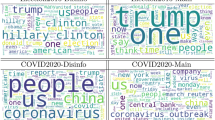Abstract
This paper describes an integrated approach for detecting inconspicuous contents in text. Inconspicuous contents can be an opinion or goal that may be disguised in some way to mislead automated methods but keeps a clear message for humans (e.g., terrorist sites). Our methodology hypothesizes that patterns that convey inconspicuous contents can be extracted, represented, generalized, and matched in unknown text. The proposed approach is meant to complement data-intensive methods (e.g. clustering). Data-intensive methods are fast but are susceptible to variations in frequency, do not discern meaning, and require a large corpus for training. Our approach relies on manual engineering for natural language interpretation and pattern extraction using no more than ten examples, but is sufficiently fast to complement a real-time application.
Preview
Unable to display preview. Download preview PDF.
Similar content being viewed by others
References
Elovici, Y., Kandel, A., Last, M., Shapira, B., Zaafrany, O.: Using Data Mining Techniques for Detecting Terror-Related Activities on the Web. Journal of Information Warfare 3(1), 17–29 (2004)
Cohen, W.M., Carvalho, V.R., Mitchell, T.M.: Learning to Classify Email into Speech Acts. In: Lin, D., Wu, D. (eds.) Proc. of the 2004 Conference on Empirical Methods in Natural Language Processing, pp. 309–316 (2004)
Yi, J., Nasukawa, T., Bunescu, R., Niblack, W.: Sentiment Analyzer: Extracting Sentiments about a Given Topic using Natural Language Processing Techniques. In: Proc. of the Third IEEE International Conference on Data Mining. IEEE Computer Society, Los Alamitos (2003)
Provost, F., Fawcett, T.: Robust Classification for Imprecise Environments. Machine Learning 42(3), 203–231 (2001)
Haller, S.: An Introduction to Interactive Discourse Processing from the Perspective of Plan Recognition and Text Planning. Artificial Intelligence Review 13, 259–311 (1999)
Marcu, D.: The Theory and Practice of Discourse Parsing and Summarization. MIT Press, Cambridge (2000)
Branting, L.K., Lester, J.C.: Justification Structures for Document Reuse. In: Smith, I., Faltings, B.V. (eds.) EWCBR 1996. LNCS, vol. 1168, pp. 76–90. Springer, Heidelberg (1996)
Weber, R.: Intelligent jurisprudence research. In: Proc. of the Seventh International Conference on Artificial Intelligence and Law, pp. 164–172. ACM, New York (1999)
Ashley, K.D.: Modeling Legal Argument: Reasoning with Cases and Hypotheticals. A Bradford book. The MIT Press, Cambridge (1990)
Brüninghaus, S., Ashley, K.D.: Bootstrapping case base development with annotated case summaries. In: Althoff, K.-D., Bergmann, R., Branting, L.K. (eds.) ICCBR 1999. LNCS (LNAI), vol. 1650, pp. 59–73. Springer, Heidelberg (1999)
Brüninghaus, S., Ashley, K.D.: Reasoning with Textual Cases. In: Munoz, H., Ricci, F. (eds.) Case-Based Reasoning Research and Applications. LNCS (LNAI). Springer, Berlin (2005)
Chandrasekaran, B., Josephson, J.R., Benjamins, V.R.: What Are Ontologies, and Why Do We Need Them? IEEE Intelligent Systems 14(1), 20–26 (1999)
Author information
Authors and Affiliations
Editor information
Editors and Affiliations
Rights and permissions
Copyright information
© 2005 Springer-Verlag Berlin Heidelberg
About this paper
Cite this paper
Weber, R., Waldstein, I., Deshpande, A., Proctor, J.M. (2005). Integrated Approach to Detect Inconspicuous Contents. In: Althoff, KD., Dengel, A., Bergmann, R., Nick, M., Roth-Berghofer, T. (eds) Professional Knowledge Management. WM 2005. Lecture Notes in Computer Science(), vol 3782. Springer, Berlin, Heidelberg. https://doi.org/10.1007/11590019_35
Download citation
DOI: https://doi.org/10.1007/11590019_35
Publisher Name: Springer, Berlin, Heidelberg
Print ISBN: 978-3-540-30465-4
Online ISBN: 978-3-540-31620-6
eBook Packages: Computer ScienceComputer Science (R0)




